Florian Schroff
Imagen 3
Aug 13, 2024Abstract:We introduce Imagen 3, a latent diffusion model that generates high quality images from text prompts. We describe our quality and responsibility evaluations. Imagen 3 is preferred over other state-of-the-art (SOTA) models at the time of evaluation. In addition, we discuss issues around safety and representation, as well as methods we used to minimize the potential harm of our models.
VideoPrism: A Foundational Visual Encoder for Video Understanding
Feb 20, 2024
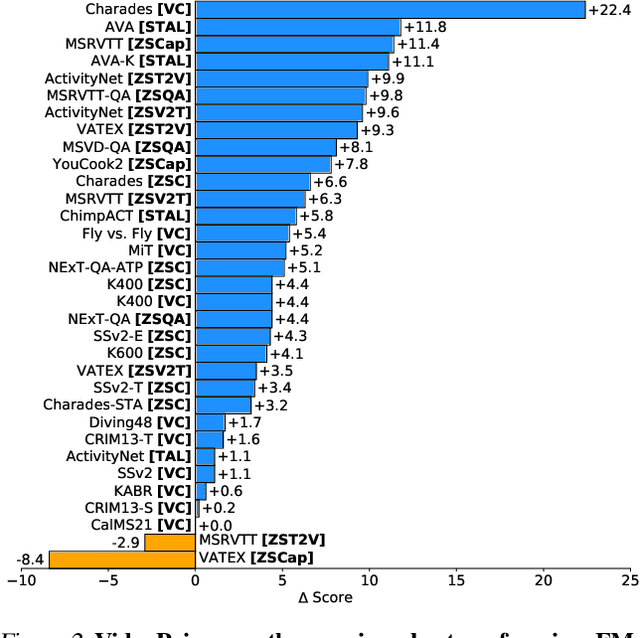

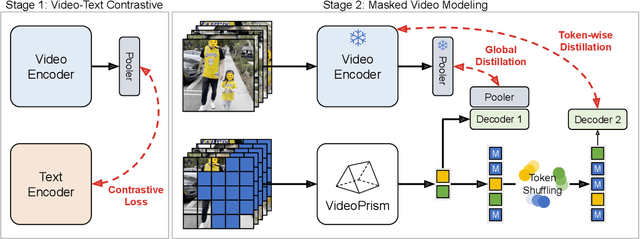
Abstract:We introduce VideoPrism, a general-purpose video encoder that tackles diverse video understanding tasks with a single frozen model. We pretrain VideoPrism on a heterogeneous corpus containing 36M high-quality video-caption pairs and 582M video clips with noisy parallel text (e.g., ASR transcripts). The pretraining approach improves upon masked autoencoding by global-local distillation of semantic video embeddings and a token shuffling scheme, enabling VideoPrism to focus primarily on the video modality while leveraging the invaluable text associated with videos. We extensively test VideoPrism on four broad groups of video understanding tasks, from web video question answering to CV for science, achieving state-of-the-art performance on 30 out of 33 video understanding benchmarks.
Distilling Vision-Language Models on Millions of Videos
Jan 11, 2024



Abstract:The recent advance in vision-language models is largely attributed to the abundance of image-text data. We aim to replicate this success for video-language models, but there simply is not enough human-curated video-text data available. We thus resort to fine-tuning a video-language model from a strong image-language baseline with synthesized instructional data. The resulting video-language model is then used to auto-label millions of videos to generate high-quality captions. We show the adapted video-language model performs well on a wide range of video-language benchmarks. For instance, it surpasses the best prior result on open-ended NExT-QA by 2.8%. Besides, our model generates detailed descriptions for previously unseen videos, which provide better textual supervision than existing methods. Experiments show that a video-language dual-encoder model contrastively trained on these auto-generated captions is 3.8% better than the strongest baseline that also leverages vision-language models. Our best model outperforms state-of-the-art methods on MSR-VTT zero-shot text-to-video retrieval by 6%.
VideoGLUE: Video General Understanding Evaluation of Foundation Models
Jul 06, 2023



Abstract:We evaluate existing foundation models video understanding capabilities using a carefully designed experiment protocol consisting of three hallmark tasks (action recognition, temporal localization, and spatiotemporal localization), eight datasets well received by the community, and four adaptation methods tailoring a foundation model (FM) for a downstream task. Moreover, we propose a scalar VideoGLUE score (VGS) to measure an FMs efficacy and efficiency when adapting to general video understanding tasks. Our main findings are as follows. First, task-specialized models significantly outperform the six FMs studied in this work, in sharp contrast to what FMs have achieved in natural language and image understanding. Second,video-native FMs, whose pretraining data contains the video modality, are generally better than image-native FMs in classifying motion-rich videos, localizing actions in time, and understanding a video of more than one action. Third, the video-native FMs can perform well on video tasks under light adaptations to downstream tasks(e.g., freezing the FM backbones), while image-native FMs win in full end-to-end finetuning. The first two observations reveal the need and tremendous opportunities to conduct research on video-focused FMs, and the last confirms that both tasks and adaptation methods matter when it comes to the evaluation of FMs.
Spatiotemporally Discriminative Video-Language Pre-Training with Text Grounding
Mar 28, 2023



Abstract:Most of existing video-language pre-training methods focus on instance-level alignment between video clips and captions via global contrastive learning but neglect rich fine-grained local information, which is of importance to downstream tasks requiring temporal localization and semantic reasoning. In this work, we propose a simple yet effective video-language pre-training framework, namely G-ViLM, to learn discriminative spatiotemporal features. Two novel designs involving spatiotemporal grounding and temporal grouping promote learning local region-noun alignment and temporal-aware features simultaneously. Specifically, spatiotemporal grounding aggregates semantically similar video tokens and aligns them with noun phrases extracted from the caption to promote local region-noun correspondences. Moreover, temporal grouping leverages cut-and-paste to manually create temporal scene changes and then learns distinguishable features from different scenes. Comprehensive evaluations demonstrate that G-ViLM performs favorably against existing approaches on four representative downstream tasks, covering text-video retrieval, video question answering, video action recognition and temporal action localization. G-ViLM performs competitively on all evaluated tasks and in particular achieves R@10 of 65.1 on zero-shot MSR-VTT retrieval, over 9% higher than the state-of-the-art method.
Unified Visual Relationship Detection with Vision and Language Models
Mar 16, 2023



Abstract:This work focuses on training a single visual relationship detector predicting over the union of label spaces from multiple datasets. Merging labels spanning different datasets could be challenging due to inconsistent taxonomies. The issue is exacerbated in visual relationship detection when second-order visual semantics are introduced between pairs of objects. To address this challenge, we propose UniVRD, a novel bottom-up method for Unified Visual Relationship Detection by leveraging vision and language models (VLMs). VLMs provide well-aligned image and text embeddings, where similar relationships are optimized to be close to each other for semantic unification. Our bottom-up design enables the model to enjoy the benefit of training with both object detection and visual relationship datasets. Empirical results on both human-object interaction detection and scene-graph generation demonstrate the competitive performance of our model. UniVRD achieves 38.07 mAP on HICO-DET, outperforming the current best bottom-up HOI detector by 60% relatively. More importantly, we show that our unified detector performs as well as dataset-specific models in mAP, and achieves further improvements when we scale up the model.
Learning to Generate Image Embeddings with User-level Differential Privacy
Nov 20, 2022



Abstract:Small on-device models have been successfully trained with user-level differential privacy (DP) for next word prediction and image classification tasks in the past. However, existing methods can fail when directly applied to learn embedding models using supervised training data with a large class space. To achieve user-level DP for large image-to-embedding feature extractors, we propose DP-FedEmb, a variant of federated learning algorithms with per-user sensitivity control and noise addition, to train from user-partitioned data centralized in the datacenter. DP-FedEmb combines virtual clients, partial aggregation, private local fine-tuning, and public pretraining to achieve strong privacy utility trade-offs. We apply DP-FedEmb to train image embedding models for faces, landmarks and natural species, and demonstrate its superior utility under same privacy budget on benchmark datasets DigiFace, EMNIST, GLD and iNaturalist. We further illustrate it is possible to achieve strong user-level DP guarantees of $\epsilon<2$ while controlling the utility drop within 5%, when millions of users can participate in training.
Contextualized Spatio-Temporal Contrastive Learning with Self-Supervision
Dec 09, 2021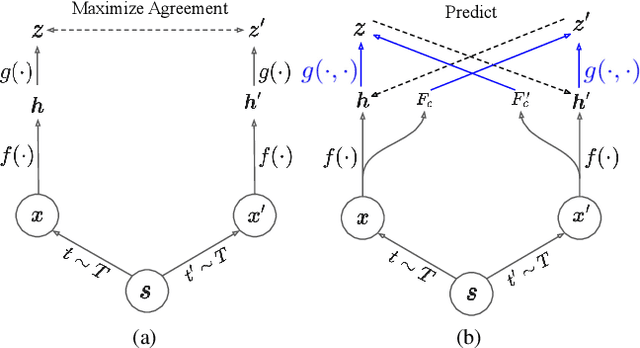

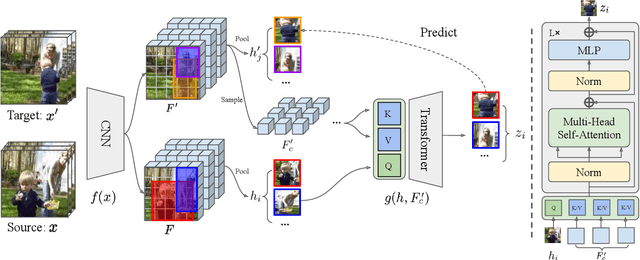
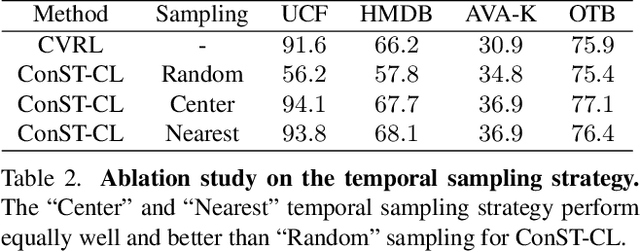
Abstract:A modern self-supervised learning algorithm typically enforces persistency of the representations of an instance across views. While being very effective on learning holistic image and video representations, such an approach becomes sub-optimal for learning spatio-temporally fine-grained features in videos, where scenes and instances evolve through space and time. In this paper, we present the Contextualized Spatio-Temporal Contrastive Learning (ConST-CL) framework to effectively learn spatio-temporally fine-grained representations using self-supervision. We first design a region-based self-supervised pretext task which requires the model to learn to transform instance representations from one view to another guided by context features. Further, we introduce a simple network design that effectively reconciles the simultaneous learning process of both holistic and local representations. We evaluate our learned representations on a variety of downstream tasks and ConST-CL achieves state-of-the-art results on four datasets. For spatio-temporal action localization, ConST-CL achieves 39.4% mAP with ground-truth boxes and 30.5% mAP with detected boxes on the AVA-Kinetics validation set. For object tracking, ConST-CL achieves 78.1% precision and 55.2% success scores on OTB2015. Furthermore, ConST-CL achieves 94.8% and 71.9% top-1 fine-tuning accuracy on video action recognition datasets, UCF101 and HMDB51 respectively. We plan to release our code and models to the public.
DeepLab2: A TensorFlow Library for Deep Labeling
Jun 17, 2021
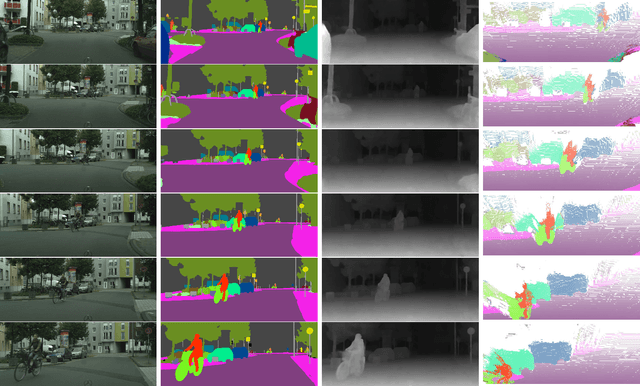
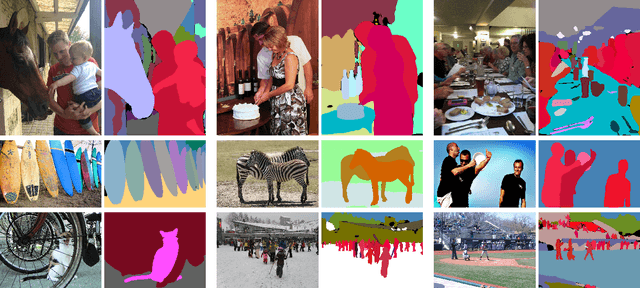
Abstract:DeepLab2 is a TensorFlow library for deep labeling, aiming to provide a state-of-the-art and easy-to-use TensorFlow codebase for general dense pixel prediction problems in computer vision. DeepLab2 includes all our recently developed DeepLab model variants with pretrained checkpoints as well as model training and evaluation code, allowing the community to reproduce and further improve upon the state-of-art systems. To showcase the effectiveness of DeepLab2, our Panoptic-DeepLab employing Axial-SWideRNet as network backbone achieves 68.0% PQ or 83.5% mIoU on Cityscaspes validation set, with only single-scale inference and ImageNet-1K pretrained checkpoints. We hope that publicly sharing our library could facilitate future research on dense pixel labeling tasks and envision new applications of this technology. Code is made publicly available at \url{https://github.com/google-research/deeplab2}.
Learning View-Disentangled Human Pose Representation by Contrastive Cross-View Mutual Information Maximization
Dec 02, 2020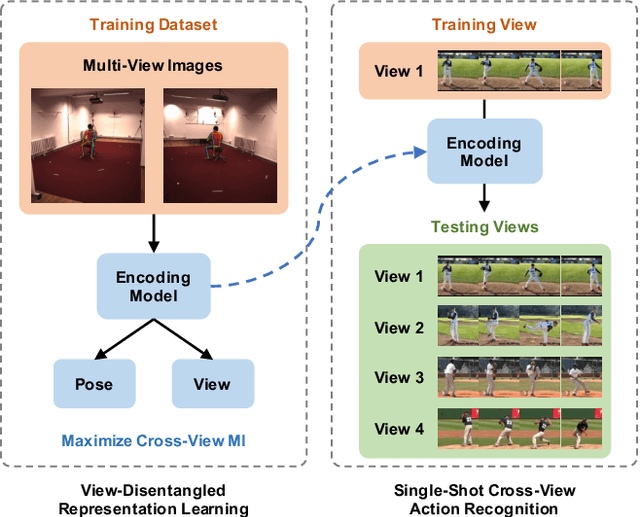
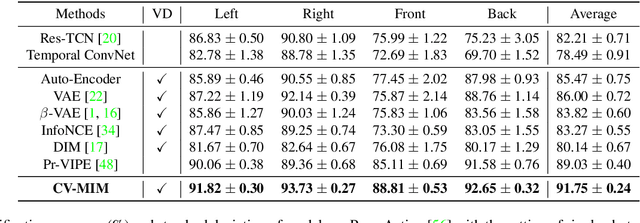

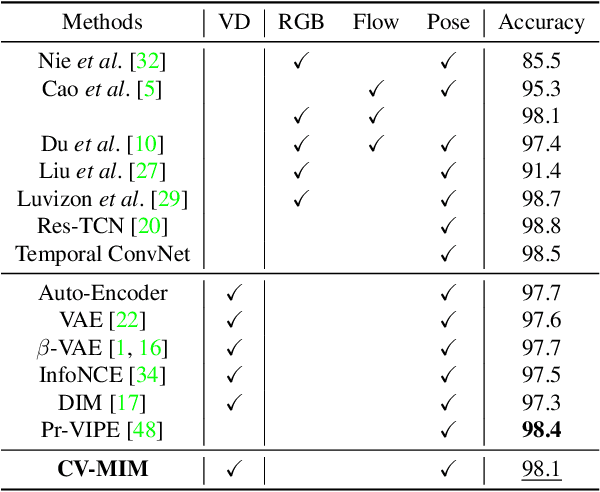
Abstract:We introduce a novel representation learning method to disentangle pose-dependent as well as view-dependent factors from 2D human poses. The method trains a network using cross-view mutual information maximization (CV-MIM) which maximizes mutual information of the same pose performed from different viewpoints in a contrastive learning manner. We further propose two regularization terms to ensure disentanglement and smoothness of the learned representations. The resulting pose representations can be used for cross-view action recognition. To evaluate the power of the learned representations, in addition to the conventional fully-supervised action recognition settings, we introduce a novel task called single-shot cross-view action recognition. This task trains models with actions from only one single viewpoint while models are evaluated on poses captured from all possible viewpoints. We evaluate the learned representations on standard benchmarks for action recognition, and show that (i) CV-MIM performs competitively compared with the state-of-the-art models in the fully-supervised scenarios; (ii) CV-MIM outperforms other competing methods by a large margin in the single-shot cross-view setting; (iii) and the learned representations can significantly boost the performance when reducing the amount of supervised training data.
 Add to Chrome
Add to Chrome Add to Firefox
Add to Firefox Add to Edge
Add to Edge